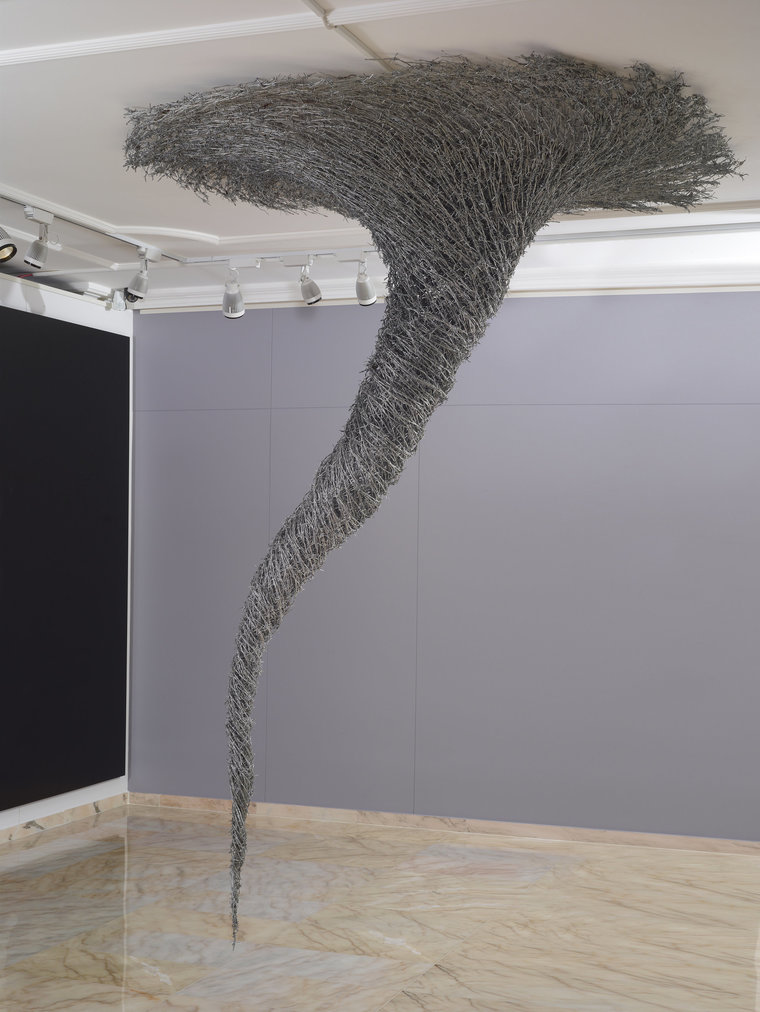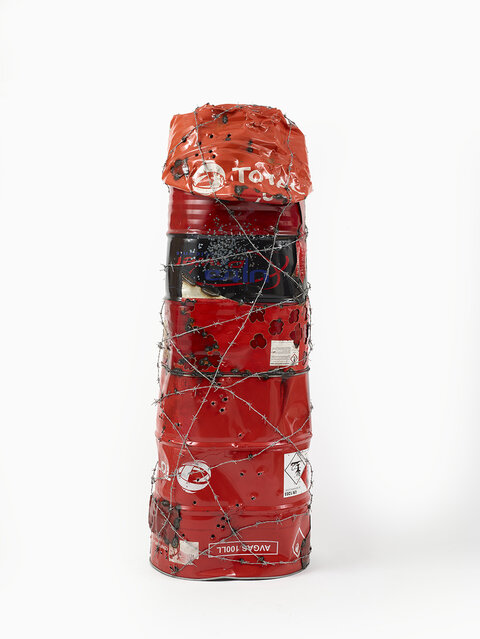The monumental Tornado, 2015, is one of Abdul Rahman Katanani’s most prominent works. It is a staggering, ceiling-mounted, barbed wire installation. The handmade woven steel wires reach a vertiginous three meters in height, as they weigh a substantial two hundred kilograms. The artwork hovers five centimeters above the ground, spiraling from narrow to wider rims, before ending in a wide oval metallic base.
Barbed wire, along with other everyday objects indigenous to Palestinian camps and territories, are a cornerstone of Katanani’s installations. In a nod to nouveau realism, the artist transforms seemingly plain items into a gateway to both a personal and collective experience. He engages the viewer in an adventurous journey of discovery and reflection. In the case of the Palestinian cause in particular, the astute use of such an accessible entry point serves to humanize a population that has been increasingly dehumanized on the world stage.
Tornado represents a far more complex reality than the obvious cyclone leaving destruction in its wake. The massive scale of the installation, its dynamic rippling, and the spiraling visual effect all suggest a refusal of the status quo. They urge for change, or even rebellion. The artist further underscores the hardships of Palestinian life through the threatening levitation of the huge mass, and the use of barbed wire. Katanani’s choice of a thorny, hostile material, used for fencing Palestinian refugee camps, makes it an overtly political medium symbolizing the harshest form of confinement.
This artwork carries a wealth of history and political statements. It is an allegory of the socio-political maelstrom that has struck the Middle East in recent history, specifically Palestine. As Katanani himself states, “for me, the Palestinian cause is not a closed circle, it is a tornado that sweeps away joy, dreams, energy, people and spirals towards the unknown”.
That all engulfing void characterizes Palestinian existence. It is perfectly symbolized in the violent turmoil of a tornado storm. The texture of metal used, being both soft and hard, malleable and thorny, is a subtle hint at the absurdity, conflict, and also richness of the human condition.
When contemplating Katanani’s Tornado, the viewer is invited on a journey teeming with contradictions. This massive steel construction is a Palestinian reality that straddles hope and hopelessness, suffering and joy, determination and surrender. The artwork represents a more universal human experience, in all of its ambivalence and polarity.
Indeed, perhaps the most glaring contradiction in Tornado is the use of a material traditionally made to keep the other out. Yet here it is used as a cross-cultural bridge to invite the other in. In doing so, Katanani’s call for liberation is loud and clear. It is both the liberation of an oppressed people from occupation, as well as the liberation of the self from its self-inflicted inner shackles. Tornado becomes the epitome of the belief that the “perfect border is no border”.



-AbdulRahmanKatnani-Front.jpg)
-AbdulRahmanKatnani-Front.jpg)
-AbdulRahmanKatnani-Front.jpg)
-AbdulRahmanKatnani-Front.jpg)
-low.jpeg)
-low.jpeg)
.jpg)
.jpg)
.jpg)
.jpg)



